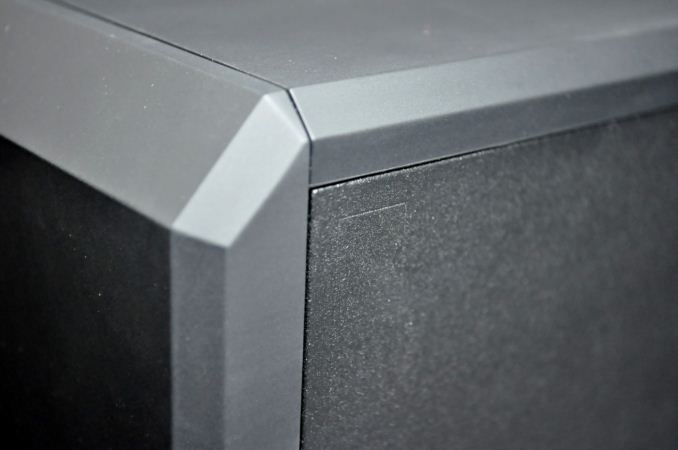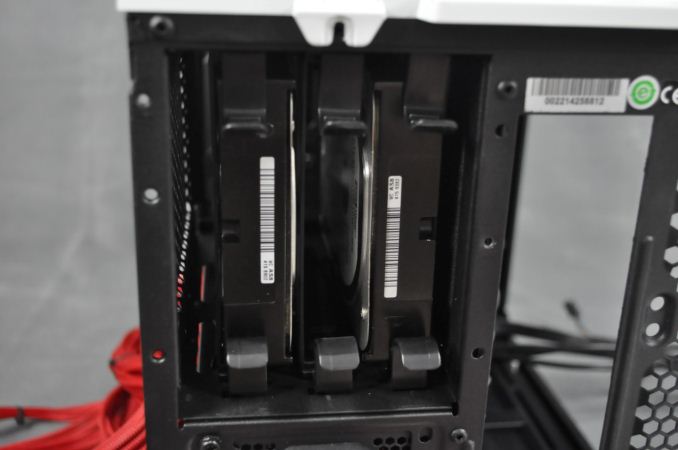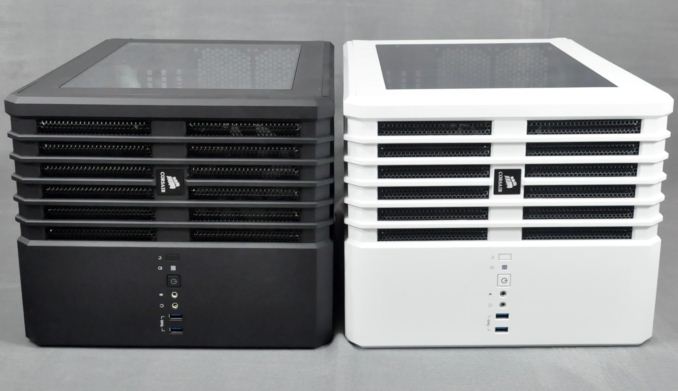Corsair Carbide Air 240 Case Review
by E. Fylladitakis on August 15, 2014 6:00 AM EST- Posted in
- Cases/Cooling/PSUs
- Corsair
- ATX
- Case
- Carbide
Corsair Carbide Air 240 Exterior
"And we shall call it…mini-540". This is what Corsair must have been thinking while designing their latest addition to the Carbide series, the Air 240. The new Micro-ATX case looks exactly like an undersized version of the Carbide Air 540 that we reviewed a little over a year ago. With a size of 315mm × 265mm × 400mm (H×W×D) and a total volume of 0.0334m3, the Carbide Air 240 is not a very compact Micro-ATX case, yet it takes less than half the volume of the Air 540 (61.55% less) and less volume than the Obsidian 350D (21.87% less). It also adds Micro-ATX compatibility over the Obsidian 250D for just 16.9% more volume.
Corsair currently offers the Carbide Air 240 in two colors, black and white, both of which are depicted in the following galleries. It is interesting to note that the metallic parts of the black version have been sprayed with a grainy, satin black paint, while a smooth matte black paint covers the plastic parts. The difference in the paint on the black isn't a major deal, but it is apparent when performing a close inspection. The white version on the other hand is immaculate, with the entire exterior having being sprayed with a satin white color.
Aesthetically, the Carbide Air 240 sports an interesting asymmetric design that hints at the internal dual-chamber configuration. The left part of the faceplate is vented, as is the left part of the top and bottom panels as well, creating exceptional cooling possibilities for the main system. We can see the I/O ports and buttons on the right middle side of the faceplate, with the company logo in alignment towards the left side of the case. The left side panel is almost entirely covered by a transparent acrylic window, revealing the entire main system to the spectator.
The top and bottom panels of the Carbide Air 240 are secured with two thumbscrews each. By removing these thumbscrews, both panels easily slide off. However, as the case actually sits on the bottom panel, it will have to be placed on its side or upside down before removing it. The removal of either panel reveals the frame for the installation of 120mm fans and/or liquid cooling radiators.
It is very interesting that Corsair went with a "rails" design, allowing the user to adjust the location of the fans/radiator by a few centimeters towards the front or the rear of the case. Each of the side panels is secured with two thumbscrews each as well, but these thumbscrews are partially threaded and do not come off the panel when removing it. The front panel can also be removed, but the user needs to first remove both side panels and undo the plastic clips that hold the front panel in place.
Even though the right side panel of the Carbide Air 240 will have to be removed before the user can wire any of the drives, both drive cages are accessible from the exterior of the case. The 2.5" drive cage is beneath the top panel, which has to be removed in order to gain access to it. The 3.5" drive cage is accessible from the rear of the case, by removing a perforated metallic cover held in place with a single thumbscrew. The plastic trays of the 3.5" cage can hold 2.5" drives as well. Strangely, even though the plastic trays have been inserted facing rightwards from the factory, they need to be installed facing leftwards in order to fit three full-size 3.5" mechanical disks.
It is also possible to use the Carbide Air 240 sideways and there are even slots on the metallic right side panel for the rubber feet that Corsair provides in the bundle. However, that will also rotate the faceplate and everything printed on it, including the I/O legend and the case badge, making the Carbide Air 240 look rather odd and off-place. The case badge is magnetic and may be rotated, but that is not true for the I/O legend and buttons.



























63 Comments
View All Comments
know of fence - Sunday, August 17, 2014 - link
Do you think that at some point in the future you could arrive at the conclusion, that coolers which consume several times the power, with their failure prone mechanical pumps and fans which also require manual speed adjustment maybe aren't worth the trouble?kyuu - Tuesday, August 19, 2014 - link
Nope, because those "failure prone" pumps and fans are a much more efficient means of cooling. We're talking about desktop systems here, so it consuming a couple extra watts of power isn't really meaningful.I don't particularly care if you prefer air cooling. There are air coolers that work very well; I currently have a Zalman air cooler on my CPU, which replaced the Zalman air cooler on my previous CPU. But CLCs have very real advantages (while not being perfect, as no technology is), so I do take issue with people railing against is though choosing CLCs is somehow wrong.
I have no idea what you're talking about with the requiring manual adjustment thing.
kyuu - Tuesday, August 19, 2014 - link
railing against it as though***Damn lack of an edit button...
StrangerGuy - Saturday, August 16, 2014 - link
IMO this case is terribly designed. If Corsair are going to make a cube case, why not just copy the 250D design, make it fit a mATX mobo and 2x120mm radiator on the left side then be done with. Made even worse without a single 5.25 bay despite all the space at the right side.kyuu - Saturday, August 16, 2014 - link
"Motherboards of up to Micro-ATX size can be installed in the Carbide Air 240, but there is a catch: if you do install a Micro-ATX motherboard, you cannot install a liquid cooling radiator at the bottom of the case. You also cannot really install one at the top panel either, since the fan alone is just a hair away from the top of the motherboard. Therefore, you basically need to choose between two GPUs and a Micro-ATX motherboard, or two large liquid cooling radiators and a Mini-ITX motherboard (presumably with one GPU)."I checked out Corsair's specs, and it says that radiators are intended to be used on the bottom mounts and the *front*. The mounts at the top of the case are not intended for radiators at all, whether you're using mATX or mini-ITX. So you can, in fact, mount a single 240mm rad with an mATX (or, presumably, two 120mm rads) on the front of the case. Which makes me interested in this case.
kyuu - Saturday, August 16, 2014 - link
Though the one thing that would give me pause is if there's room for a thick (~50mm) push/pull radiator on the bottom. Looks like one might not fit due to the GPU, though a thinner one or one with a single fan might.Etern205 - Friday, August 29, 2014 - link
Never like this Corsair case, they want to make it like a cube. A cube is suppose to be compact and yet this is way too large. One problem I still don't get is the back and forth bickering about 5.25" drive bays. I still have a optical drive that I use occasionally, because it's the fastest method for me to install games as I prefer physical media as my bandwidth is consider slow compare to all the others, and other have bandwidth caps, so downloading a 15GB game is out of the question. Also 5.25" drives aren't just only for optical drives. It's not like the computer won't boot up or literally spit out the optical drive. You can use it for many other things like, LCD fan controllers, HDD bays, and many other stuffs. It's useful if you know what to do with it.kenoh - Sunday, August 31, 2014 - link
You can install 3-3.5" HDD's, but how many SSD's can you install?kenoh - Sunday, August 31, 2014 - link
Is it possible for this case to hold 4 SSD's, with all three HDD's installed? BTW, what PSU is used in this review?mekpro - Saturday, September 13, 2014 - link
That's Abit Motherboard !